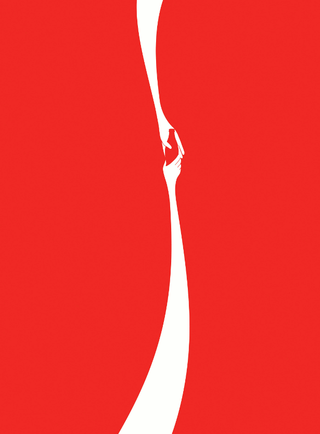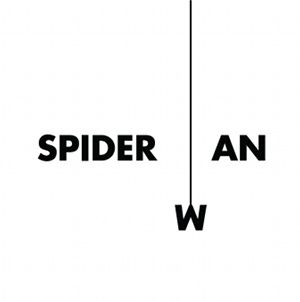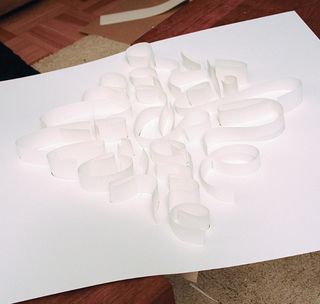Do clients care about design awards?
Can the number of trophies on your studio’s shelf help win over clients, or is it all about the kudos? As 2013’s awards season kicks into gear, Garrick Webster investigates what it really means for a design business
The annual awards season is in full swing, and as we go to press, organisations like D&AD, The One Club and Cannes Lions are licking the envelopes marked ‘Winners Inside’.
Lavish exhibitions and awards dinners are being planned, annuals are being readied for print and the design industry is holding its collective breath in anticipation of the winners being announced, and the celebrations that will follow.
Perhaps some of the work you can see throughout this feature will be up on stage being rewarded. Our opening image, for instance, was created by Taku Satoh Design Office in Tokyo as part of its Pleats Please campaign for Issey Miyake. Having picked up the Gold Prize at the ADC Awards, it’s also been nominated for a Pencil in D&AD’s Graphic Design category.
“It’s a great honour,” enthuses Taku Satoh. “These awards allow our activities to be visible to even more people. They also provide inspiration for future jobs.”
Yet amid the excitement of the awards season, there will be plenty of cynical muttering too. The view that awards consist of the usual suspects slapping one another on the back in mutual self-congratulation isn’t new. Even D&AD’s CEO Tim Lindsay admits there may be a grain of truth to it – certain faces do turn up on the awards circuit more than others. However, this brand of cynicism isn’t confined just to the design industry. From the Oscars to the Golden Joysticks and on to the Turner Prize and the Booker, there will always be healthy scrutiny of the winners, which then spools back into the selection process; who was judging; possible conspiracies and so on.
Despite procedural imperfections and perceived injustices, however, awards schemes definitely have a useful part to play in the design industry. Hard-working and talented people deserve recognition, and as illustrator and D&AD 2013 Pencil nominee Marion Deuchars points out, it goes far beyond receiving ‘kudos’. In fact, she thinks that’s the wrong word. “I don’t think it’s just about the kudos – respect amongst your peers is important,” she insists. “It’s also nice to be acknowledged for the work you do. Most of us don’t only make work for ourselves but for others, and awards are a way of recognising that effort.”

Beyond recognition, it’s about giving credit where it’s due. Whereas Deuchars’ Pencil-nominated book How to Make Great Fingerpaint Art has her name on the cover, in many parts of the industry creatives are kept anonymous. From TV advertising to outdoor campaigns and on to digital projects, individuals’ names are rarely attached to the work. Kevin Swanepoel is president of The One Club in New York, which hosts the annual One Show awards. “This industry is a very tough industry to be in,” he says. “Creatives get told ‘no’ daily; ideas get shot down time and time again. There is no credit roll after an ad, like in the movies. Creatives and the people who do this great work really need recognition.”
There is always plenty of debate as to whether or not winning awards gets you clients. Michael Johnson, founder of johnson banks, has won over 20 industry awards – including eight D&AD Pencils. He can only recall one occasion when an award led directly to a brief. Illustrator Simon Spilsbury has both D&AD Pencils and several AOI Illustration medals to his name. What have they done for him? “No idea,” he laughs. “No one phones you and says, ‘I’m giving you a commission because you won a D&AD Pencil award.’”
If you’re victorious, however, you do get the opportunity to describe yourself or your studio as ‘award-winning’. This should give clients confidence in working with you, if they understand the award and its value. “There’s an old adage – win a Yellow Pencil, get a promotion; win a Black Pencil, start your own agency,” smiles D&AD chief executive officer Tim Lindsay. “A Pencil may not get you work directly, but it is reassurance. A client knows they’re in safe hands if they know you’ve been awarded by a jury of the top minds in the business.”

Of course, winning a design award can give you plenty of exposure too, which can be of critical importance when you’re just starting out. Illustrator Lizzie Mary Cullen won her first gong straight out of college with a silver medal in New Talent at the Association of Illustrators Awards in 2008. Then she snagged another win at New Designers in London, generating a buzz around her work. The prize itself was useful in practical ways too – she took home a copy of Adobe’s Creative Suite Master Collection. “New Designers put me in touch with so many amazing leads,” says Cullen. “I got so many commissions from that one show; it was really a dream to win.”
Yet as Cullen admits, there has been a psychological downside to winning these awards so early in her blossoming career. “It gave me a massive head for a while, which is never good. Also, you can start to get worried. If I don’t win anything one year, I begin to think I’m crap: not really the right attitude,” she admits. “I’m beginning to realise that winning awards is a fantastic validation from the panel and your peers, but what really matters is your work,” she adds.

After the highs of winning, going to work the next day can bring you back down to Earth with a thump. Fellow designers may marvel at your Pencils, medals, Cubes, light bulbs, springs, Lions and other trophy configurations, but your hard-headed boss might take a different view.
David Hillman, foreman of D&AD’s 2013 Graphic Design jury, made his name working in publishing in the early 1970s and now runs his own design studio. “While I was art director of Nova magazine we won a gold and three silvers in one evening,” Hillman recalls. “The morning after I was summoned to the publishing director’s office and told that the magazine was not published for the benefit of my ego,” he goes on. “In the design business, I don’t think clients are as impressed as in the ad industry.”
For Yates Buckley, technical director and co-founder of digital production house UNIT9, awards have played an undeniable role in the development of his company. He was a judge at this year’s One Show, after many years as an award recipient. In fact, his company has won prizes from over 40 different organisations including D&AD, the One Show, the Clios, Cannes Lions and Webby awards. “They have done a lot, at different stages in our career,” he says. “Today perhaps they are a reassuring measure that our work has not got worse; about 10 years ago, the first big awards were important because they reassured our clients that we could deliver excellence.”

Many in the industry now believe that there are just too many awards and award categories out there these days. The prizes themselves lose their value. On the other hand, the multiplicity of awards has only followed a boom in the number of ways designers and their clients now reach their audiences. Buckley continues: “There is a proliferation of platforms, media, channels, formats – it’s a bit crazy to have all these English words for something to watch and interact with. I am pretty sure the proliferation will limit itself at some point. I know already of certain awards where they have significantly reduced categories and works awarded to maintain quality.”
Jung von Matt/Limmat is up for a D&AD Pencil in Magazine and Newspaper Design for a promotional project that turned the front page of a Zurich newspaper into binary code. “I think there are too many award shows out there,” confesses executive creative director Alexander Jaggy. “We try to reduce our entries to several award shows per year – a handful of Swiss festivals including the Effies, and a handful of international shows.”
D&AD he singles out as one of the shows to enter if you really want to test your work against the best in the world. “D&AD may be the toughest competition on Earth,” he continues. “The odds of winning must be in the thousands to one range. Sometimes you have to put your work to the test. That’s why we enter the D&AD Awards, and that’s why we are very proud of the nomination.” With 51 years under its belt, D&AD is one of the world’s most established and renowned awards shows. This year it ran 24 professional categories and accepted over 12,000 entries, comprised of 20,000 pieces of work – which went on display at Olympia in April.
Hundreds of pieces of work made it into the D&AD Annual, including all the projects featured here – a not-insignificant achievement in itself. Crucially, juries only award Yellow or Black Pencils if they think the work merits it, aren’t limited to the number of awards given out, and are not compelled to award something if they don’t think anything in the category is good enough. Some years we’ve seen no Pencils at all in Graphic Design, for instance. Like other top awards schemes, D&AD has worked fastidiously to make sure the judges are of the highest calibre. Tom Hingston runs his own award-winning studio, working with everyone from Nokia to Massive Attack. He judged the Crafts for Design category, and certainly took his role seriously: “The work is specifically judged on the strength of its craft and the quality of its execution, and secondly on how it contributes to the success of the idea,” he explains. “There are then three main criteria – most importantly, is it an original and inspiring idea, is it well executed, and then finally, is it relevant to its context. Broadly speaking, these criteria act as stakes in the ground to help guide the process of judging on the day.”

The better the judging, the more respected the awards scheme, both at home and around the world. “Now the Awards are truly global: we receive over 80 per cent of our entries from overseas,” reveals D&AD’s Liam Fay-Fright. “This reflects the globalisation of our industry, and the correlative increase in the quality of design and advertising from emerging economies. Brazil and China are two of our biggest growing markets.”
New Zealand-based Alt Group sees awards as a way to gauge the quality of its work versus that of its international peers, according to co-founder and creative director Dean Poole. While the country’s domestic design industry has an improving reputation, it can still feel geographically and culturally isolated out there in the South Pacific.
“It’s a reality check to be judged by your peers on the global stage; it gives you a nudge to try a little harder,” believes Poole. “When a project gets judged well in a design award then that’s great, because it also gives our clients confidence to take more risks and trust the creative process,” he goes on. “What we do sometimes is ambiguous, difficult and ephemeral – and awards schemes enable you to reflect on what you’ve done and where.”
In line with the globalisation of design, one of the most nominated and most awarded pieces so far this year comes from China. The #CokeHands campaign was overseen by Graham Fink, chief creative officer at Ogilvy & Mather in Shanghai, with the actual artwork created by young Hong Kong illustrator Jonathan Mak. Coming from a developing market like China, award-winning work like this can send a powerful message to the rest of the industry, and may even attract other talented designers keen to take on the challenge themselves. “Since moving to China, I now want us to compete with the best in the world,” says Fink. “I am trying to build the best creative departments in Asia, and am always looking for people to come here and help inspire the world.” Ogilvy & Mather Shanghai enters all the big international awards, he explains, including Cannes and D&AD, as well as various local shows. “It’s important to produce work that works in our local culture too,” he adds.
Of course, awards will always be important to those who win, but what about to the thousands and thousands who enter and walk away with nothing? And what about those who don’t enter at all, but observe from the sidelines?
Certainly there’s something to be learned from entering and missing out. The winning work, and the exhibitions and annuals that many schemes create, are a source of inspiration. According to Michael Johnson, if you find one category dull, another might light your fire: “I rarely find the Graphics category at D&AD that inspirational, but I like to see the winners in Product, Environmental and Interactive – they seem so much more exciting,” he enthuses. “Maybe that’s a comment on the static nature of graphics.”
Johnson continues: “Having said that, seeing all the work at D&AD before the ‘cull’ is often a kick up the arse: you get a real feel for the state of creativity in the world when you’re surrounded by 10,000 bits of work. That’s quite something, and the process is often very inspirational.”
Get the Creative Bloq Newsletter
Daily design news, reviews, how-tos and more, as picked by the editors.

Beyond the inspiration, and the social functions that awards ceremonies fulfil, it’s also heartening to see some awards schemes – particularly the non-profit ones – giving back to the industry. The One Club, for instance, has a growing educational programme, and monies raised through awards entry fees are used on design scholarships for young talents from underprivileged backgrounds. D&AD has an admirable and long-standing educational programme, runs Student and New Blood awards, and recently unveiled a special trophy – the White Pencil – for creative work done in the charity sector. It rewards designers who set out to use their skills to make a difference.
The creative industry seems to view awards with hopeful enthusiasm, and a dollop of cynicism. Perhaps that’s because our minds are trained to ask questions. A judge, award winner and a cynic, Yates Buckley continues to strive for the best, asking questions all the while: “I find nothing odd with keeping a schizophrenic total cynicism toward the system, while at the same time understanding that this is the very best we can do right now,” he says.
“The question I have is: ‘But then what?’ In Spinal Tap the volume could go up to 11, but that was just a new limit. What if you want to really rock but you’re already playing at 11, what can you do? Maybe we now need to have awards for the largest number of awards won.” That, however, threatens to start a whole new debate.

Thank you for reading 5 articles this month* Join now for unlimited access
Enjoy your first month for just £1 / $1 / €1
*Read 5 free articles per month without a subscription

Join now for unlimited access
Try first month for just £1 / $1 / €1
The Creative Bloq team is made up of a group of design fans, and has changed and evolved since Creative Bloq began back in 2012. The current website team consists of eight full-time members of staff: Editor Georgia Coggan, Deputy Editor Rosie Hilder, Ecommerce Editor Beren Neale, Senior News Editor Daniel Piper, Editor, Digital Art and 3D Ian Dean, Tech Reviews Editor Erlingur Einarsson and Ecommerce Writer Beth Nicholls and Staff Writer Natalie Fear, as well as a roster of freelancers from around the world. The 3D World and ImagineFX magazine teams also pitch in, ensuring that content from 3D World and ImagineFX is represented on Creative Bloq.
